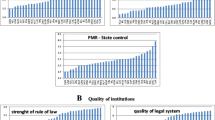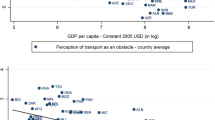Abstract
This article provides evidence about the impact of corporate taxation on both labor and capital demand by private companies in a developing economy, using firm level data from Chile. Our results show that higher corporate tax rates reduce not only the demand for capital, but also the demand for labor due to complementarities between both inputs. An interesting element of the results presented in this article is the asymmetry between the effects of taxation according to company size. The impact on labor demand is significantly higher in large corporations than in small enterprises, while the demand for capital is more responsive to corporate tax changes in small firms. We can explain these results based on differences in credit constraints according to firm size.






Similar content being viewed by others
Notes
The sample period is mainly determined by data availability. Nonetheless, the corporate tax rate has had little variability over the last 10 years; it is currently 17%.
As measures of human capital, he uses—among others—the number and average age of proprietors, and their work and business experience in the area of work. After controlling for this, he concludes than financial rationing is not supported by the evidence.
We define Prof it as \( {\text{Prof}}_{{it}} = \frac{{P^{Y}_{t} }} {{P^{K}_{t} }}\frac{{\alpha Y_{{it}} }} {{K_{{it}} }} - \delta _{{it}} \), where the index i indicates firm and t indicates year, the variable Y it is the aggregate value added per firm, K it is the capital stock per firm while \( \frac{{P^{Y}_{t} }} {{P^{K}_{t} }} \), the relative price of output vis-à-vis capital is measured by means of the national account price deflators. In order to construct this variable we assume a capital stock share in output α = 0.4.
To rank firms, we compute the average firm’s sales over our time period.
References
Benavente, J. M, Galetovic, A., & Sanhueza, R. (2005). La Dinámica Industrial y la Financiación de las PYME. El Trimestre Económico, 52(286), 217–254.
Bustos, A., Engel, E., & Galetovic, A. (2004). Could higher taxes increase the long-run demand for capital? Theory and evidence for Chile. Journal of Development Economics, 73, 675–697.
Cabrera, A., de la Cuadra, S., Galetovic, A., & Sanhueza, R. (2002). Las Pyme: Quiénes son, cómo son y qué hacer con ellas, mimeo. Chile: Sociedad de Fomento Fabril.
Carrol, R., Holtz-Eakin, D., Rider, M., & Rosen, H. (2000). Income taxes and entrepreneurs’ use of labor. Journal of Labor Economics, 18(2), 324–351.
Cerda, R., & Larraín, F. (2005). Inversión Privada e Impuestos Corporativos: Evidencia para Chile. Cuadernos de Economía, 42(126), 257–281.
Cressy, R. (1996). Are business startups debt-rationed. The Economic Journal, 106(438), 1253–1270.
Cressy, R. (2006). Why do most firms die young. Small Business Economics, 26, 103–116.
Hall, R., & Jorgenson, D. (1967). Tax policy and investment behavior. American Economic Review, 57, 391–414.
Hamermesh, D. S. (1993). Labor demand. Princeton: Princeton University Press.
Heckman, J., & Pages, C. (2000). The cost of job security regulation: Evidence from Latin American labor markets. Economía, 2, 109–154.
Hsieh, C. & Parker, J. (2006). Taxes and growth in a financially underdeveloped country: Evidence from the Chilean investment boom. NBER working paper, 12104.
Jorgenson, D. (1963). Capital theory and investment behavior. American Economic Review Papers and Proceedings, 53, 247–259.
Martínez, C., Morales, G., & Valdés, R. (2001). Cambios Estructurales en la Demanda por Trabajo en Chile. Economía Chilena, 4, 5–25.
Medina, J. P., & Valdés, R. (1998). Flujo de Caja y Decisiones de Inversión en Chile: Evidencia de Sociedades Anónimas Abiertas, Cuadernos de Economía, 35(106), 301–323.
Tobin, J. (1969). A general equilibrium approach to monetary theory. Journal of Money, Credit and Banking, 1, 15–29.
Vergara, R. (2007). Taxation and private investment: Evidence for Chile. Applied Economics (in press). doi: 10.1080/00036840701720747.
Wooldridge, J. M. (2002). Econometric analysis of cross section and panel data. Cambridge: MIT Press.
Acknowledgements
We thank useful comments from two anonymous referees and the editor Rui Baptista. We also acknowledge the extremely able research assistance of Francisco Parro and Felipe Varas. All remaining errors remain own responsibility.
Author information
Authors and Affiliations
Corresponding author
Appendix
Appendix
1.1 A. Measuring the capital stock and depreciation rate
The construction of the capital stock in the micro dataset follows a reversal version of the perpetual inventory method. Let us define:
-
S = buildings (e), machinery (m) or vehicles (v);
-
\( K^{s}_{{it}} \) = capital stock type s of firm i at year t;
-
\( I^{s}_{{it}} \) = investment type s of firm i at year t;
-
δs = type s depreciation rate.
Our dataset has available data on annual investment plus capital stock at the end of the sample. Capital stock data in other periods might be missing. In order to construct the series of capital stock in each firm, we assume the following annual depreciation rates:
-
δe: buildings, 2%;
-
δm: machinery, 8%;
-
δv: vehicles, 15%.
We assume that the capital stock type s in a firm follows the traditional law of motion:
Also, let T be the final period of our sample; as we have available \( K^{s}_{{iT}} \), we may obtain \( K^{s}_{{iT - 1}} \) as follows:
By recursion, we may obtain the sequence of capital stock as in:
Once we obtain the series of each type of capital stock per firm, we obtain the total capital stock per firm by adding up the all the types of capital as in:
The average depreciation rate is calculated as:
where E it , M it , V it are capital stock in buildings, machinery and vehicles in year t, respectively.
1.2 B. The reduced form equations
This section presents the cost-minimization problem faced by the firm. We assume the firms use labor, capital, and an imported intermediate good in the production of the final good. The firm has a Cobb-Douglas production function of the form
where Y, K, L and M are output, capital, labor, and an intermediate imported good. Let w, c, and x denote the wage, the cost of capital and the price of the imported good. Following the user cost of capital approach we assume the cost of capital is given by \( c = {\left( {r + \delta - {\left( {p^{e}_{{t + 1}} - p_{t} } \right)}} \right)}{\left( {1 - \tau } \right)}, \) where r is the relevant interest rate, δ is the depreciation rate, \( p^{e}_{{t = 1}} - p \) is the expected capital gain and τ correspond to the corporate tax rate. Then, we can write the following cost minimization problem of the firm:
with the associated first-order conditions:
Rearranging the first-order conditions and replacing them into the production function leads to the following labor demand equation:
where
Finally, replacing c and using the approximation log(1 − τ) ≈ −τ, we obtain the conditional labor demand function, Eq. 6 in the text, as in:
In Eq. 6 we assume that there are no capital gains. This assumption is necessary because we do not have such data for each firm in our microeconomic dataset.
Rights and permissions
About this article
Cite this article
Cerda, R.A., Larrain, F. Corporate taxes and the demand for labor and capital in developing countries. Small Bus Econ 34, 187–201 (2010). https://doi.org/10.1007/s11187-008-9113-2
Received:
Accepted:
Published:
Issue Date:
DOI: https://doi.org/10.1007/s11187-008-9113-2




